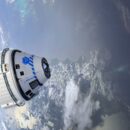This is not investment advice. The author has no position in any of the stocks mentioned. Wccftech.com has a disclosure and ethics policy.
NASA and Boeing shared more details earlier today for the ongoing Starliner CFT mission at the International Space Station (ISS) with astronauts Butch Wilmore and Sunita Williams on board the orbiting space laboratory. Starliner took to the skies earlier this year after multiple delays, and after it docked at the station, NASA chose to delay its return indefinitely as it works with Boeing to test the ship's thrusters on the service module.
These thrusters are responsible for maneuvering the ship away from the station during its return, and they can only be tested in space as of now since the service module burns up in the atmosphere after it's jettisoned before Starliner enters the Earth's atmosphere.
NASA Stresses That Starliner Is Designed to Spend 210 Days In Space
As part of its Starliner evaluation to test the ship's thrusters, NASA has now decided to run tests on the ground at the military's White Sands test facility. NASA's Commercial Crew Program manager, Steve Stich, explained that ground tests have covered seals and flanges on the thruster system to understand the root causes of the helium leaks. The tests in White Sands will check whether there's a chance of exposure to toxic vapors by replicating thruster firings during flight.
NASA will put "a new thruster through the same profile that we saw in the uphill phase, on orbit insertion all the way to docking." The thruster will then be put in a profile mirroring the downhill phase, after which engineers will analyze the thruster to ensure there are no problems, explained Stich.
He added that while Starliner is designed to spend 210 days in space, teams are currently updating a "45 day limit" stemming from the crew module's batteries. NASA is evaluating the batteries and their performance, and the limit should be updated since the batteries are being charged by the space station. With the extra time, NASA will be "watching the vehicle, we'll be watching the way the heaters work on the prop system, we're watching the way the space station continues to power the vehicle, [and] characterizing the thermal performance of vehicle."

Boeing's vice president and Starliner manager Mark Nappi stressed that the crew is not stuck on the space station. He lamented most media coverage of the mission, and added that Boeing will would be unable to evaluate Starliner's long duration performance had the crew returned according to the original plan.
According to Nappi, Boeing is focused on understanding how to fix Starliner's problems permanently, and to fix them, his firm is working through fault trees with as many as a hundred potential causes for the fault. Collecting data helps Boeing remove potential causes, and once a "few" causes are narrowed down, Boeing can start to apply fixes.
Boeing will try to replicate the outcomes of a thruster hot fire during Starliner's docking with the ground tests in White Sands. This will allow it to determine future courses of action, such as more hot fire tests in space or additional hot fires as Starliner un docks from the ISS.
Later during the call, Stich shared that "we realized that it's gonna take longer than we initially planned for certification." Teams are right now focused on the flight test, according to the NASA official, and the data gathered during the ongoing flight should help with certification.




